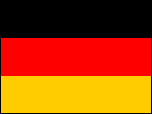 German
German German
GermanAs in English, the obstruents are traditionally classified pairwise as "voiced" and "voiceless", though periodicity is a less reliable feature than duration and intensity, and they are therefore better termed "lenis" and "fortis".
The six plosives are p b t d k g:
Symbol Word Transcription p Pein paIn b Bein baIn t Teich taIC d Deich daIC k Kunst kUnst g Gunst gUnstThe voicing and aspiration patterning of German plosives is similar to that of English, with the unaspirated variant occcurring after initial /S/ or (in a few words) /s/.
[If it is desired to symbolise the glottal stop explicitly, it may be shown in SAMPA as shown here.]
? Verein fE6"?aInThere are three phonemic affricates that are considered to be native to German,
pf ts tS, and a fourth one, dZ, which occurs in a few loanwords, and which is often replaced by tS:
pf Pfahl pfa:l ts Zahl tsa:l tS deutsch dOYtS dZ Dschungel "dZUN=lThere are ten fricatives,
f v s z S Z C j x h. j is often realised as a vowel glide.
f fast fast v was vas s Tasse "tas@ z Hase "ha:z@ S waschen "vaS=n Z Genie Ze"ni: C sicher "zIC6 j Jahr ja:6 x Buch bu:x h Hand hantThe sonorants are three nasals,
m n N, and two "liquids", l R, of which R can be realised as a uvular fricative (voiced or voiceless depending on context), a uvular approximant, or a uvular tap or trill:
m mein maIn n nein naIn N Ding dIN l Leim laIm R Reim RaImOrthographic <r> is realised phonetically in a number of different ways:
R (as above).
r, e.g. <Reim> -- raIm.
6 (see below).
The checked vowels are I E a O U Y 9:
I Sitz zIts E Gesetz g@"zEts a Satz zats O Trotz trOts U Schutz SUts Y hübsch hYpS 9 plötzlich "pl9tslICThere are 8 pure free vowels,
i: e: E: a: o: u: y: 2:, and three free diphthongs, aI aU OY:
i: Lied li:t e: Beet be:t E: spät SpE:t a: Tat ta:t o: rot ro:t u: Blut blu:t y: süß zy:s 2: blöd bl2:t aI Eis aIs aU Haus haUs OY Kreuz krOYtsThe unstressed "schwa" vowel is:
@ bitte "bIt@The vowel realisation of <r>, represented as
6, fuses with schwa, but it also follows stressed vowels, resulting in additional centring diphthongs:
6 besser "bEs6 i:6 Tier ti:6 I6 Wirt vI6t y:6 Tür ty:6 Y6 Türke "tY6k@ e:6 schwer Sve:6 E6 Berg bE6k E:6 Bär bE:6 2:6 Föhr f2:6 96 Wörter "v96t6 a:6 Haar ha:6 a6 hart ha6t u:6 Kur ku:6 U6 kurz kU6ts o:6 Ohr o:6 O6 dort dO6t

Verbmobil SAMPA-D-VMlex documentation (in German)

SAMPA home page
UCL Phonetics and Linguistics home page
University College London home page
Maintained by J.C. Wells. Last amended 1996 03 18